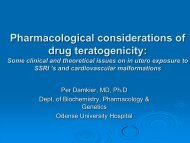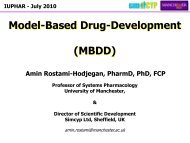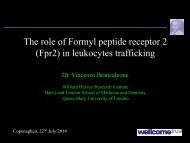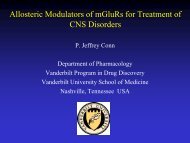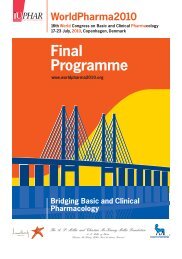New approaches to fill the methods gap in pharmacovigilance
New approaches to fill the methods gap in pharmacovigilance
New approaches to fill the methods gap in pharmacovigilance
- No tags were found...
You also want an ePaper? Increase the reach of your titles
YUMPU automatically turns print PDFs into web optimized ePapers that Google loves.
The <strong>pharmacovigilance</strong> ‘<strong>to</strong>ol kit’5Wise et al Nature Drug Disc 2009
European Medic<strong>in</strong>es Agency priorities foradverse drug reaction research2009-4th Call FP72010-5th Call FP7Long-term effects <strong>in</strong> children and <strong>in</strong>young adults of methylphenidateInsul<strong>in</strong>/<strong>in</strong>sul<strong>in</strong> analogues anddevelopment of cancerLong-term adverse effects ofimmunomodula<strong>to</strong>rs (monoclonalantibodies)Anti-diabetes drugs and cardio/cerebrovascular adverse effectsand pancreatitis/pancreatic cancerLong-term adverse skeletal effectsof bisphosphonatesMedic<strong>in</strong>e use <strong>in</strong> pregnancySuicidal behaviour <strong>in</strong> relation <strong>to</strong>certa<strong>in</strong> drug use(antidepressants,antipsychotics, varenicl<strong>in</strong>e,montelukast)Safety aspects of antipsychotics<strong>in</strong> demented patientsEpoet<strong>in</strong>s: Risk of tumour growthprogression and thromboembolicevents <strong>in</strong> cancer patients andcardiovascular and cancer risk <strong>in</strong>chronic kidney diseaseAsthma treatments: risk ofmyocardial ischaemia and longtermsafety, especially <strong>in</strong> childrenGadol<strong>in</strong>ium-conta<strong>in</strong><strong>in</strong>g contrastagents: Nephrogenic systemicfibrosis (NSF) and long-term effectson <strong>the</strong> bone7
European Medic<strong>in</strong>es Agency priorities foradverse drug reaction research2009-4th Call FP72010-5th Call FP7Long-term effects <strong>in</strong> children and<strong>in</strong> young adults of methylphenidateInsul<strong>in</strong>/<strong>in</strong>sul<strong>in</strong> analogues anddevelopment of cancerLong-term adverse effects ofimmunomodula<strong>to</strong>rs (monoclonalantibodies)Anti-diabetes drugs and cardio/cerebrovascular adverse effectsand pancreatitis/pancreatic cancerLong-term adverse skeletaleffects of bisphosphonatesMedic<strong>in</strong>e use <strong>in</strong> pregnancySuicidal behaviour <strong>in</strong> relation <strong>to</strong>certa<strong>in</strong> drug use (antidepressants,antipsychotics, varenicl<strong>in</strong>e,montelukast)Safety aspects of antipsychotics <strong>in</strong>demented patientsEpoet<strong>in</strong>s: Risk of tumour growthprogression and thromboembolicevents <strong>in</strong> cancer patients andcardiovascular and cancer risk <strong>in</strong>chronic kidney diseaseAsthma treatments: risk ofmyocardial ischaemia and longtermsafety, especially <strong>in</strong> childrenGadol<strong>in</strong>ium-conta<strong>in</strong><strong>in</strong>g contrastagents: Nephrogenic systemicfibrosis (NSF) and long-termeffects on <strong>the</strong> bone8
9Struggle 1: long-term adverse effects
10Struggle 1: long-term adverse effects
Long-term treatment: >6 monthsbuild<strong>in</strong>g <strong>the</strong> safety database for approval The number of patients treated for 6 months at dosagelevels <strong>in</strong>tended for cl<strong>in</strong>ical use, should be adequate <strong>to</strong>characterise <strong>the</strong> pattern of ADEs over time. (n=300-600) ADEs that <strong>in</strong>crease <strong>in</strong> frequency or severity with time orthat may occur only after > 6 months of treatment. (n=100treated for 1 year) <strong>to</strong>tal number of <strong>in</strong>dividuals treated with <strong>the</strong> <strong>in</strong>vestigationaldrug, <strong>in</strong>clud<strong>in</strong>g short-term exposure, will be about 1500.11
Benefit-risk balance at time of approval--> Many long-term effects are assessed post-approval12
Efalizumab & PML riskArch Derma<strong>to</strong>l 2009Safety database at time of approval (2003): 2764 patients treated 218 >1 yearFDA post–approval commitment: 5 year surveillance study, n=500013
How <strong>to</strong> perform long-term follow-up?build a registry Cl<strong>in</strong>icaltrials.gov (July 16, 2010) Observational registry n=553 Obvservational registry long-term n=92• Drug n=24• Drug+compara<strong>to</strong>r n=6• Disease n=23• Device n=21• Cell <strong>the</strong>rapy n=2• Procedure n=16Disease registriesD:A:D Data collection on Adverse events of anti-HIV DrugsTNF <strong>in</strong>hibi<strong>to</strong>r users (British Society of Rheuma<strong>to</strong>logy)UK epilepsy and Pregnancy RegisterThe Hunter outcomes Survey (set up by idursulphase company)14
From s<strong>in</strong>gle-product <strong>to</strong> disease-basedregistries?15Askl<strong>in</strong>g J. ENCePP Scientific Convention ‘EU health care databases for pan-EUpharmacoepidemiological research’, London, 25 November 2008.
Limitations of registries Compara<strong>to</strong>r group Limited active surveillance time Adverse event of <strong>in</strong>terest may be diagnosed by physiciansoutside <strong>the</strong> disease registry16
Limitations of registries Compara<strong>to</strong>r group Limited active surveillance time Adverse event of <strong>in</strong>terest may be diagnosed by physiciansoutside <strong>the</strong> disease registryHypo<strong>the</strong>tical solution? Patients <strong>in</strong>cluded <strong>in</strong> Phase III trials should give <strong>in</strong>formedconsent <strong>to</strong> follow <strong>the</strong>m for life through passive surveillance17
Study<strong>in</strong>g long-term effects <strong>in</strong> databasesmethodological challenges Selection bias Who are long-term users? Health-seek<strong>in</strong>g behavior Well-controlled Co-medicationIf selection <strong>to</strong> rema<strong>in</strong> <strong>in</strong> <strong>the</strong> cohort is based on fac<strong>to</strong>rsrelated <strong>to</strong> outcome, <strong>the</strong>n results will be biased18
Study<strong>in</strong>g long-term effects <strong>in</strong> databasesmethodological challenges Selection bias Who are long-term users? Health-seek<strong>in</strong>g behavior Well-controlled Co-medicationIf selection <strong>to</strong> rema<strong>in</strong> <strong>in</strong> <strong>the</strong> cohort is based on fac<strong>to</strong>rsrelated <strong>to</strong> outcome, <strong>the</strong>n results will be biased Some analytic options Comparison of <strong>in</strong>itia<strong>to</strong>rs vs. <strong>in</strong>itia<strong>to</strong>rs and model time-vary<strong>in</strong>ghazards Comparison of switchers vs. switchers consider<strong>in</strong>g cumulativemedication his<strong>to</strong>ry from <strong>in</strong>itiation until switch (dose, duration,etc).19
20Struggle 2: drug-<strong>in</strong>duced malignancies
21Struggle 2: drug-<strong>in</strong>duced malignancies
22Struggle 2: drug-<strong>in</strong>duced malignancies
Insul<strong>in</strong>e glarg<strong>in</strong>e and cancer risk 4 observational studies Hemkens et al submitted <strong>to</strong> ‘Diabe<strong>to</strong>logia’ The journal wanted confirmation and asked 3 o<strong>the</strong>r groups<strong>to</strong> perform replication studies23
Insul<strong>in</strong>e glarg<strong>in</strong>e and cancer risk 4 observational studies Hemkens et al submitted <strong>to</strong> ‘Diabe<strong>to</strong>logia’ The journal wanted confirmation and asked 3 o<strong>the</strong>r groups<strong>to</strong> perform replication studies Conclusions Hemkens: <strong>the</strong> cancer <strong>in</strong>cidence with glarg<strong>in</strong>e was higherthan expected compared with human <strong>in</strong>sul<strong>in</strong>. Jonasson: women us<strong>in</strong>g <strong>in</strong>sul<strong>in</strong> glarg<strong>in</strong>e alone had an<strong>in</strong>creased <strong>in</strong>cidence rate of breast cancer as compared withwomen us<strong>in</strong>g types of <strong>in</strong>sul<strong>in</strong> o<strong>the</strong>r than <strong>in</strong>sul<strong>in</strong> glarg<strong>in</strong>e. Currie: Use of <strong>in</strong>sul<strong>in</strong> analogues was not associated with<strong>in</strong>creased cancer risk as compared with human <strong>in</strong>sul<strong>in</strong>. Colhoun: <strong>in</strong>sul<strong>in</strong> glarg<strong>in</strong>e use was not associated with an<strong>in</strong>creased risk of all cancers or site-specific cancers and <strong>the</strong>n <strong>the</strong>re was panic......24
25Insul<strong>in</strong>e glarg<strong>in</strong>e and cancer risk
Inves<strong>to</strong>rs are react<strong>in</strong>g promptly <strong>to</strong>rumours of safety publications26Gale EAM. Diabe<strong>to</strong>logia 2009; 52: 1975-82.
Let’s have a closer lookstudy design issues that could have been tackled Exposure misclassification Whole follow-up period was looked at: cont<strong>in</strong>uous users vsswitchers vs non-use Exposure measured dur<strong>in</strong>g a 4 -6 month run-<strong>in</strong> period Solution: time-vary<strong>in</strong>g exposue measument Selection bias Incident users mixed with prevalent users, while hazardchange over time Proportion of prevalent users differs per drug and per study Type 1 and type 2 diabetes, different proportions Solution: subgroup analyses Different compara<strong>to</strong>r groups Human <strong>in</strong>sul<strong>in</strong> Insul<strong>in</strong> o<strong>the</strong>r that glarg<strong>in</strong>e27
28European Medic<strong>in</strong>es Agengy conclusions
Struggles rema<strong>in</strong><strong>in</strong> observational drug-<strong>in</strong>duced malignany research Hazard patterns: tumour <strong>in</strong>itiation (5 yrs) , tumourpromotion (1 yr) Compar<strong>in</strong>g users of drug A with users of drug B given thattreatment allocation is never random. (Longterm) exposure measurement and classification given<strong>the</strong> dynamics of diabetes treatment. The underly<strong>in</strong>g disease (diabetes) is associated with <strong>the</strong>outcome; <strong>in</strong>sul<strong>in</strong> itself has also mi<strong>to</strong>genic characteristics. How <strong>to</strong> fac<strong>to</strong>r <strong>in</strong> relevant data on BMI, alcohol, smok<strong>in</strong>g,etc?29
30Take home messages
Take home messages Active risk management needs more time <strong>to</strong> ‘<strong>in</strong>filtrate’ <strong>the</strong>whole ‘drug landscape’31
Take home messages Active risk management needs more time <strong>to</strong> ‘<strong>in</strong>filtrate’ <strong>the</strong>whole ‘drug landscape’ Every new safety issue has its own specific (drug, patient ordisease related) methodological problems and may need <strong>to</strong>be studied <strong>in</strong> detail, I prefer common sense over guidel<strong>in</strong>es32
Take home messages Active risk management needs more time <strong>to</strong> ‘<strong>in</strong>filtrate’ <strong>the</strong>whole ‘drug landscape’ Every new safety issue has its own specific (drug, patient ordisease related) methodological problems and may need <strong>to</strong>be studied <strong>in</strong> detail, I prefer common sense over guidel<strong>in</strong>es Observational (post-market<strong>in</strong>g) studies, <strong>in</strong>clud<strong>in</strong>g registriesand database studies can be very useful, but stay alert andask for help if <strong>methods</strong> are challeng<strong>in</strong>g33
34Thank you for your attention



